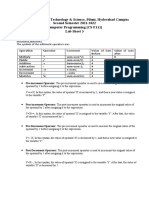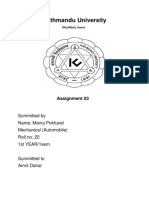Assignment Operators: Op Era Tor Meaning / % + - &
Uploaded by
naveen reddyAssignment Operators: Op Era Tor Meaning / % + - &
Uploaded by
naveen reddyAssignment Operators
Op
era
tor
Meaning
= Store the value of the second operand in the object specified by the first operand (simple assignment).
*=
Multiply the value of the first operand by the value of the second operand; store the result in the object
specified by the first operand.
/=
Divide the value of the first operand by the value of the second operand; store the result in the object
specified by the first operand.
%=
Take modulus of the first operand specified by the value of the second operand; store the result in the
object specified by the first operand.
+=
dd the value of the second operand to the value of the first operand; store the result in the object
specified by the first operand.
=
Subtract the value of the second operand from the value of the first operand; store the result in the object
specified by the first operand.
<<
=
Shift the value of the first operand left the number of bits specified by the value of the second operand;
store the result in the object specified by the first operand.
>>
=
Shift the value of the first operand right the number of bits specified by the value of the second operand;
store the result in the object specified by the first operand.
&=
!btain the bit"ise #D of the first and second operands; store the result in the object specified by the first
operand.
^=
!btain the bit"ise e$clusive !% of the first and second operands; store the result in the object specified by
the first operand.
|=
!btain the bit"ise inclusive !% of the first and second operands; store the result in the object specified by
the first operand.
Design and simulate your o"n fu&&y setpoint controller
You might also like
- Addis Ababa University, Amist Kilo July 4, 2011 Algorithms and Programming For High SchoolersNo ratings yetAddis Ababa University, Amist Kilo July 4, 2011 Algorithms and Programming For High Schoolers3 pages
- Application Development Using Python - Unit 2-2No ratings yetApplication Development Using Python - Unit 2-229 pages
- C Operators, Operands, Expressions & StatementsNo ratings yetC Operators, Operands, Expressions & Statements26 pages
- Part 4-Operators and Expressions-15.03.2024No ratings yetPart 4-Operators and Expressions-15.03.202417 pages
- Principles of Programming using C_UNIT-2_NotesNo ratings yetPrinciples of Programming using C_UNIT-2_Notes43 pages
- Operators N Expressions in C EngineersTutor 1No ratings yetOperators N Expressions in C EngineersTutor 111 pages
- Expressions and Operators in C++: Study Guide For Module No. 4No ratings yetExpressions and Operators in C++: Study Guide For Module No. 414 pages
- Fundamentals of Programming Lec-4.Pptx (1)No ratings yetFundamentals of Programming Lec-4.Pptx (1)26 pages
- Computer Programming DAM 23603: Expressions and OperatorsNo ratings yetComputer Programming DAM 23603: Expressions and Operators41 pages
- Implementation of An FSK Modem Using The TMS320C17: Application Report: Spra080No ratings yetImplementation of An FSK Modem Using The TMS320C17: Application Report: Spra08062 pages
- Precision Digital Sine-Wave Generation With The TMS32010: Application Report: Spra007No ratings yetPrecision Digital Sine-Wave Generation With The TMS32010: Application Report: Spra00723 pages
- Appendix A Phase Lock Loops: x (t) = A cos (ω t + θ (t) )No ratings yetAppendix A Phase Lock Loops: x (t) = A cos (ω t + θ (t) )36 pages
- Creating A Two Channel Sine Wave Generator Using The TMS320F240 EVMNo ratings yetCreating A Two Channel Sine Wave Generator Using The TMS320F240 EVM34 pages
- Interpolation in Microcontroller Based Instrumentation and Control ProjectsNo ratings yetInterpolation in Microcontroller Based Instrumentation and Control Projects4 pages
- Pasquale Arpaia, Pasquale Cimmino, Fabrizio Clemente, Carmine RomanucciNo ratings yetPasquale Arpaia, Pasquale Cimmino, Fabrizio Clemente, Carmine Romanucci5 pages
- Life Extension Through Charge Equalization of Lead-Acid BatteriesNo ratings yetLife Extension Through Charge Equalization of Lead-Acid Batteries8 pages
- One Piece Design W/ Screw Clamp TerminationNo ratings yetOne Piece Design W/ Screw Clamp Termination1 page
- Table 1: Coil Calculations For High Voltage Power SupplyNo ratings yetTable 1: Coil Calculations For High Voltage Power Supply6 pages




































































